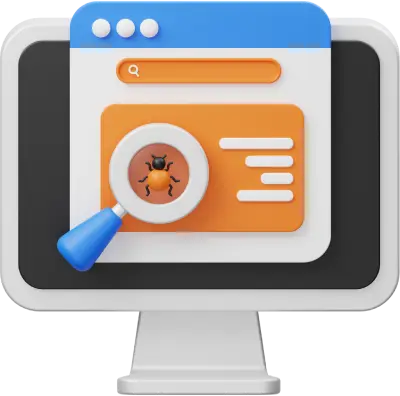Vulnerability Assessment and Penetration Testing (VAPT)
Web Application Penetration Testing involves assessing the security of web applications to identify vulnerabilities and weaknesses that could be exploited by attackers. It is crucial for ensuring the integrity, confidentiality, and availability of web-based services.
How It's Performed:

Reconnaissance
Understanding the web application's architecture, technologies, and functionalities.

Threat Modeling
Identifying potential threats and attack vectors based on the web app's functionalities and components.

Static Analysis
Analyzing the source code, scripts, and configurations of the web application to uncover vulnerabilities without executing the application.

Dynamic Analysis
Interacting with the web application in real-time to identify security vulnerabilities while it's running.

Network Analysis
Monitoring network traffic generated by the web application to detect vulnerabilities related to data transmission and communication.

Authentication and Authorization Testing
Assessing the strength of authentication mechanisms and verifying that users have appropriate access privileges.

Input Validation Testing
Testing for various injection vulnerabilities such as SQL injection, XSS, and other forms of code injection.

Error Handling Testing
Evaluating the web application's response to unexpected inputs and errors.

Session Management Testing
Testing how the web application manages user sessions and ensuring session tokens are securely handled.

Data Security Testing
Reviewing data handling practices to ensure sensitive information is stored, transmitted, and protected securely.

API Testing
Testing the security of APIs used by web applications to interact with servers and other services.

Reverse Engineering
Analyzing the web application's behavior and responses to understand its inner workings and identify potential vulnerabilities.
Process of Web Penetration Testing:
1. Information Gathering
2. Vulnerability Scanning:
3. Manual Testing
4. Analysis and Reporting
5. Penetration Testing
6. Risk Assessment
7. Remediation Guidance
8. Reassessment
1. Information Gathering
2. Vulnerability Scanning:
3. Manual Testing
4. Analysis and Reporting
5. Penetration Testing
6. Risk Assessment
7. Remediation Guidance
8. Reassessment

Why It's Useful:
- Risk Mitigation: Identifies and addresses security vulnerabilities to reduce the risk of data breaches and unauthorized access.
- Compliance Requirements: Helps organizations meet regulatory standards for web application security.
- Cost Savings: Identifies and fixes security issues before incidents occur, saving costs associated with breaches and fines.
- Continuous Improvement: Regular testing helps adapt to evolving threats and maintain the security posture of web applications over time.
Common Vulnerabilities for website pentesting
- Broken access control
- Cryptographic failures
- Injection
- Insecure design
- Security misconfiguration
- Vulnerable and outdated components
- Identification and authentication failures
- Software and data integrity failures
- Security logging and monitoring failures
- Server-side request forgery.
Tools commonly used for Web Application Pentesting
Tools commonly used for Web Application Pentesting
Need penetration testing for your digital asset?
If yes, please fill the 'Get a Quote' form and submit it. Our security expert will be reaching you directly and take it forward.
Frequently Asked Questions?
Common security vulnerabilities found in web applications include SQL Injection (SQLi), Cross-Site Scripting (XSS), Cross-Site Request Forgery (CSRF), Insecure Direct Object References (IDOR), Security Misconfigurations, Broken Authentication, Insecure Deserialization, and Injection Attacks.
Common tools and techniques for web application penetration testing include Burp Suite, OWASP ZAP, Nmap, Metasploit Framework, Nessus, Nikto, Acunetix, SQLMap, and Wireshark. These tools help in identifying vulnerabilities such as SQL injection, XSS, CSRF, and security misconfigurations.
Common tools and techniques for web application penetration testing include Burp Suite, OWASP ZAP, Nmap, Metasploit Framework, Nessus, Nikto, Acunetix, SQLMap, and Wireshark. These tools help in identifying vulnerabilities such as SQL injection, XSS, CSRF, and security misconfigurations.
- Check for default credentials and weak password policies.
- Test session management for issues like session fixation and hijacking.
- Attempt to access unauthorized functionality or resources.
- Verify secure implementation of third-party authentication mechanisms.
- Review access controls and privilege escalation possibilities.
To ensure the security of APIs used by web applications, we typically:
- Implement proper authentication and authorization mechanisms.
- Use HTTPS to encrypt data transmission.
- Validate and sanitize input parameters to prevent injection attacks.
- Implement rate limiting and throttling to protect against brute-force attacks.
- Monitor and log API requests for suspicious activity.
- Regularly update and patch API servers to address vulnerabilities.
Testing for SQL injection vulnerabilities involves sending specially crafted SQL queries as input to web forms or URL parameters to identify if the application is vulnerable to injection attacks. Techniques such as SQLmap, manual input manipulation, and automated vulnerability scanners can be used to detect and exploit SQL injection vulnerabilities. Remediation involves using parameterized queries, input validation, and secure coding practices to prevent SQL injection attacks.
Protecting against XSS attacks involves implementing input validation and output encoding to sanitize user-supplied input and prevent malicious scripts from being executed in the browser. Content Security Policy (CSP) headers can be used to mitigate the impact of XSS attacks by restricting the sources from which content can be loaded. Additionally, regular security training for developers and implementing security controls in the development lifecycle can help prevent XSS vulnerabilities.
Assessing the security of session management involves testing for session fixation, session hijacking, and session timeout vulnerabilities. This includes verifying the randomness and uniqueness of session identifiers, ensuring secure transmission of session tokens, and validating session expiration mechanisms. Tools such as Burp Suite, OWASP ZAP, and manual testing techniques can be used to assess session management security. Remediation involves implementing secure session management practices and encryption of session data.
Testing for file inclusion vulnerabilities involves sending malicious input to web application parameters that accept file paths or filenames, such as file upload forms or include statements in code. Techniques such as local file inclusion (LFI) and remote file inclusion (RFI) can be tested using tools like Burp Suite, ZAP, or manual testing. Remediation involves validating and sanitizing user-supplied input, restricting access to sensitive files, and implementing proper file access controls.
Assessing input validation mechanisms involves testing for various types of input validation vulnerabilities, such as buffer overflows, format string vulnerabilities, and command injection. Techniques such as fuzzing, boundary testing, and static code analysis can be used to identify input validation vulnerabilities. Remediation involves implementing proper input validation checks, using secure coding practices, and sanitizing user input to prevent injection attacks.
Securing server-side components involves implementing proper access controls, validating user input, and sanitizing output to prevent injection attacks. Additionally, regularly updating and patching server software, configuring secure communication protocols (e.g., TLS/SSL), and implementing strong authentication mechanisms can help mitigate server-side vulnerabilities. Regular security assessments and audits can also help identify and remediate security issues in server-side components.

